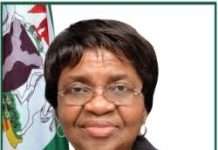One third of more than 700 health facilities in Borno State, north-eastern Nigeria, have been completely destroyed, according to a report released today by WHO. Of those facilities remaining, one third are not functioning at all.
“High insecurity, difficult terrain and lack of health workers, medicines, equipment and basic amenities such as safe water are making access to essential, lifesaving health care extremely difficult for people in this conflict-affected area,” says Dr Wondi Alemu, WHO Representative in Nigeria.
“WHO’s top priority is to help save lives and prevent sickness among the estimated 6 million people who need health assistance in this crisis.”
WHO has been working with the Borno State Ministry of Health to set up a Health Resources Availability Monitoring System (known as HeRAMS) to collect information on the availability of health resources and services in this humanitarian crisis.
The first report from this new system has identified 743 health facilities in Borno State, of which 35% are completely destroyed, another 29% partially damaged and only 34% intact. About 100 temporary health facilities have been set up to support the response, of which 49 are emergency clinics for displaced people living in camps.
Of the 481 health facilities that have not been destroyed, 31% of them are not functioning, mostly as a result of lack of access due to insecurity. Almost 60% of health facilities have no access to safe water (32% have no access to any water at all) and 3 out of 4 (73%) facilities do not have enough chlorine stocks to decontaminate the water used in the facility.
“The information from this system is critical to inform the management of Borno State Ministry of Health and its partners on gaps that need to be addressed urgently,” says Mr Kadai Baba Gana, deputy director for Planning, Research and Statistics in the Borno State Ministry of Health and the HeRAMS task team chairman. “This will help us to better coordinate and monitor the response and guide the allocation of scarce resources.”
HeRAMS is a rapid online system used to monitor which health facilities, services and resources are available and accessible in emergency settings. Health workers are trained by WHO to enter key information into the system about the clinic or hospital where they work. This information includes the kind of services the facility can provide, whether the infrastructure has essential resources like electricity and water, the skills of health workers, and the type of services, equipment and medicines available as well as support received from external partners. Information is updated regularly to help monitor improvements or new gaps in services.
Around 60% of the health facilities in north-eastern Nigeria are currently being supported by one or more of the 18 health partners responding to the crisis.
WHO is working closely with these partners to support the government to deliver essential lifesaving health services, gather and analyse key health information and prepare for and respond to disease outbreaks.
WHO has a strong presence in the community in these areas thanks to a well-established polio programme which includes teams of health workers trained to work in areas of high insecurity and reach communities that no other partner can reach.
However, more resources are needed. The United Nations and partners need US$ 94 million to provide health services to 6 million people, more than half of them children, in this crisis. Of this share, WHO needs US$ 31 million to deliver on its response plans in 2017.












tadalafil dosage: http://tadalafilonline20.com/ tadalafil max dose